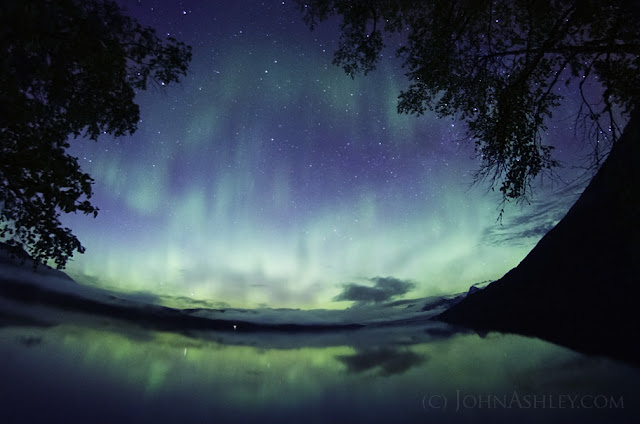 |
| Northern lights this morning over Lake McDonald, in Glacier National Park |
Night owls enjoyed the silent aurora borealis as far south as Colorado, including here in cloudy Montana. I made it to Lake McDonald about 30 minutes past midnight, just in time to enjoy the last half hour of northern lights before low fog and high clouds smothered the colors. Most of what I saw were green shimmering waves, but higher up there were also a few magenta lights that made a brief appearance just as the clouds moved in.
Typically, northern lights are set off when a sunspot - a humongous belch of the sun's plasma - occurs on the side of the sun that's facing Earth (the sun also rotates). The electromagnetic storm reaches Earth a couple of days later. This year is supposed to see a peak of sunspot activity, which runs in 11-year cycles. (There are several northern lights forecast links over in the right hand column.)
But last night's solar storm was not typical. Instead of a sunspot, the electrical storm that swept across our little planet was was caused by an unexpected, interplanetary shock wave. Last night's turbulence was thought to originate from ripples in the solar winds.
We fly through the solar winds every day, here on the third rock from the sun. As the sun makes one complete rotation every 27 Earth-days, it flings highly-charged electrons and protons off into space. This solar wind blows continuously, filling our solar system and then some. It's been compared to a flowing skirt around a spinning dancer. The ripples are caused by winds of different speeds spinning away from the sun.
The so-called slow solar winds leave the sun at only 248 miles per second, while the fast winds leave at 466 miles per second. Where fast and slow rub together, turbulence occurs. Today we flew through one of these invisible pockets of solar turbulence. And as we fly around our solar system, the Earth also sweeps up an estimated 40,000 tons of interplanetary dust every year.
By the way, all this flinging of electrons and protons means that our star, the Sun, is loosing mass at the rate of roughly 4.4 to 6.6 billion tons every hour. But relax. It's only lost about 0.01% of its mass to the solar winds, so don't let the thought keep you up at night - unless they are predicting northern lights.

